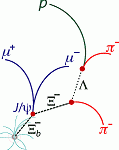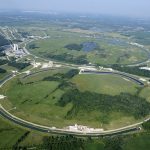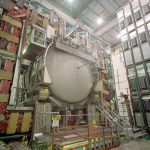Three-quark particle contains one quark from each family.
Batavia, Ill. – Physicists of the DZero experiment at the Department of Energy’s Fermi National Accelerator Laboratory have discovered a new heavy particle, the Ξb (pronounced “zigh sub b”) baryon, with a mass of 5.774±0.019 GeV/c2, approximately six times the proton mass. The newly discovered electrically charged Ξbbaryon, also known as the “cascade b,” is made of a down, a strange and a bottom quark. It is the first observed baryon formed of quarks from all three families of matter. Its discovery and the measurement of its mass provide new understanding of how the strong nuclear force acts upon the quarks, the basic building blocks of matter.
The DZero experiment has reported the discovery of the cascade b baryon in a paper submitted to Physical Review Letters on June 12.
“Knowing the mass of the cascade b baryon gives scientists information they need in order to develop accurate models of how individual quarks are bound together into larger particles such as protons and neutrons,” said physicist Robin Staffin, Associate Director for High Energy Physics for the Department of Energy’s Office of Science.
The cascade b is produced in high-energy proton-antiproton collisions at Fermilab’s Tevatron. A baryon is a particle of matter made of three fundamental building blocks called quarks. The most familiar baryons are the proton and neutron of the atomic nucleus, consisting of up and down quarks. Although protons and neutrons make up the majority of known matter today, baryons composed of heavier quarks, including the cascade b, were abundant soon after the Big Bang at the beginning of the universe.
The Standard Model elegantly summarizes the basic building blocks of matter, which come in three distinct families of quarks and their sister particles, the leptons. The first family contains the up and down quarks. Heavier charm and strange quarks form the second family, while the top and bottom, the heaviest quarks, make the third. The strong force binds the quarks together into larger particles, including the cascade b baryon. The cascade b fills a missing slot in the Standard Model.
Prior to this discovery, only indirect evidence for the cascade b had been reported by experiments at the Large Electron-Positron collider at the CERN Laboratory near Geneva, Switzerland. For the first time, the DZero experiment has positively identified the cascade b baryon from its decay daughter particles in a remarkably complex feat of detection. Most of the particles produced in high-energy collisions are short-lived and decay almost instantaneously into lighter stable particles. Particle detectors such as DZero measure these stable decay products to discover the new particles produced in the collision.
Once produced, the cascade b travels several millimeters at nearly the speed of light before the action of the weak nuclear force causes it to disintegrate into two well-known particles called J/Ψ (“jay-sigh”) and Ξ– (“zigh minus”). The J/Ψ then promptly decays into a pair of muons, common particles that are cousins of electrons. The Ξ– baryon, on the other hand, travels several centimeters before decaying into yet another unstable particle called a Λ (“lambda”) baryon, along with another long-lived particle called a pion. The Λ baryon too can travel several centimeters before ultimately decaying to a proton and a pion. Sifting through data from trillions of collisions produced over the last five years to identify these final decay products, DZero physicists have detected 19 cascade b candidate events. The odds of the observed signal being due to something other than the cascade b are estimated to be one in 30 million.
DZero is an international experiment of about 610 physicists from 88 institutions in 19 countries. It is supported by the Department of Energy, the National Science Foundation, and a number of international funding agencies. Fermilab is a national laboratory funded by the Office of Science of the U.S. Department of Energy, operated under contract by Fermi Research Alliance, LLC.
Notes for editors:
The DZero paper on the cascade b discovery is available in the hep/ex preprint location at http://arxiv.org/abs/0706.1690.
- Six quarks–up, down, strange, charm, bottom and top–are the building blocks of matter. Protons and neutrons are made of up and down quarks, held together by the strong nuclear force. The DZero experiment has discovered the Cascade-b particle, which contains a down quark (d), strange quark (s) and bottom quark (b). It is the first particle ever observed with one quark from each generation of particles.
- The Cascade-b particle (Ξb) is short-lived. Once produced, it travels only several millimeters before the action of the weak nuclear force causes it to disintegrate into two well-known particles called J/Ψ and Ξ-. The J/Ψ then promptly decays into a pair of muons, common particles that are cousins of electrons. The Ξ- baryon, on the other hand, travels several centimeters before decaying into yet another unstable particle called a Λ baryon, along with another long-lived particle called a pion. The Λ baryon too can travel several centimeters before ultimately decaying to a proton and a pion.
- The Fermilab accelerator complex accelerates protons and antiprotons close to the speed of light. Converting energy into mass, the Tevatron collider can produce particles that are heavier than the protons and antiprotons that are colliding. The Tevatron produces millions of proton-antiproton collisions per second, maximizing the chance for discovery. Two experiments, CDF and DZero, search for new types of particles emerging from the collisions.
- The DZero detector is about the size of a 3-story house. The detector surrounds the collision point and records the path, energy and charge of short-lived particles emerging from the collisions. Its subsystems record the “debris” emerging from high-energy proton-antiproton collisions, unveiling the forces governing the subatomic world. Tracing the particle tracks back to the center of the collision, scientists discover what processes take place at the core of proton-antiproton collisions.
- Some of the 700 scientists of the DZero collaboration in front of the DZero detector shortly before it began taking data in 2001.
DZero collaborating institutions:
- Universidad de Buenos Aires, Buenos Aires, Argentina
- LAFEX, Centro Brasileiro de Pesquisas Fisicas, Rio de Janeiro, Brazil
- Universidade do Estado do Rio de Janeiro, Rio de Janeiro, Brazil
- Instituto de Fisica Teorica, Universidade Estadual Paulista, Sao Paulo, Brazil
- University of Alberta, McGill University, Simon Fraser University and York University, Canada
- University of Science and Technology of China, Hefei, People’s Republic of China
- Universidad de los Andes, Bogota, Colombia
- Charles University, Center for Particle Physics, Prague, Czech Republic
- Czech Technical University, Prague, Czech Republic
- Institute of Physics, Academy of Sciences, Center for Particle Physics, Prague, Czech Republic
- Universidad San Francisco de Quito, Quito, Ecuador
- Laboratoire de Physique Corpusculaire, IN2P3-CNRS, Universite Blaise Pascal, Clermont-Ferrand, France
- Laboratoire de Physique Subatomique et de Cosmologie, IN2P3-CNRS, Universite de Grenoble, Grenoble, France
- CPPM, IN2P3-CNRS, Universite de la Mediterranee, Marseille, France
- Laboratoire de l’Accelerateur Lineaire, IN2P3-CNRS et Universite Paris-Sud, Orsay, France
- LPNHE, Universites Paris VI and VII, IN2P3-CNRS, Paris, France
- DAPNIA/Service de Physique des Particules, CEA, Saclay, France
- IPHC, IN2P3-CNRS, Universite Louis Pasteur Strasbourg, and Universite de Haute Alsace, France
- Institut de Physique Nucleaire de Lyon, IN2P3-CNRS, Universite Claude Bernard, Villeurbanne, France
- RWTH Aachen, III. Physikalisches Institut A, Aachen, Germany
- Universitat Bonn, Physikalisches Institut, Bonn, Germany
- Universitat Freiburg, Physikalisches Institut, Freiburg, Germany
- Universitat Mainz, Institut fur Physik, Mainz, Germany
- Ludwig-Maximilians-Universitat Munchen, Munchen, Germany
- Fachbereich Physik, University of Wuppertal, Wuppertal, Germany
- Panjab University, Chandigarh, India
- Delhi University, Delhi, India
- Tata Institute of Fundamental Research, Mumbai, India
- University College Dublin, Dublin, Ireland
- Korea Detector Laboratory, Korea University, Seoul, Korea
- SungKyunKwan University, Suwon, Korea
- CINVESTAV, Mexico City, Mexico
- FOM-Institute NIKHEF and University of Amsterdam/NIKHEF, Amsterdam, The Netherlands
- Radboud University Nijmegen/Nikhef, Nijmegen, The Netherlands
- Joint Institute for Nuclear Research, Dubna, Russia
- Institute for Theoretical and Experimental Physics, Moscow, Russia
- Moscow State University, Moscow, Russia
- Institute for High Energy Physics, Protvino, Russia
- Petersburg Nuclear Physics Institute, St. Petersburg, Russia
- Lund University, Royal Institute of Technology, Stockholm University, and Uppsala University, Sweden
- Lancaster University, Lancaster, United Kingdom
- Imperial College, London, United Kingdom
- University of Manchester, Manchester, United Kingdom
- University of Arizona, Tucson, Arizona, USA
- Lawrence Berkeley National Laboratory and University of California, Berkeley, California, USA
- California State University, Fresno, California, USA
- University of California, Riverside, California, USA
- Florida State University, Tallahassee, Florida, USA
- Fermi National Accelerator Laboratory, Batavia, Illinois, USA
- University of Illinois at Chicago, Chicago, Illinois, USA
- Northern Illinois University, DeKalb, Illinois, USA
- Northwestern University, Evanston, Illinois, USA
- Indiana University, Bloomington, Indiana, USA
- University of Notre Dame, Notre Dame, Indiana, USA
- Purdue University Calumet, Hammond, Indiana, USA
- Iowa State University, Ames, Iowa, USA
- University of Kansas, Lawrence, Kansas, USA
- Kansas State University, Manhattan, Kansas, USA
- Louisiana Tech University, Ruston, Louisiana, USA
- University of Maryland, College Park, Maryland, USA
- Boston University, Boston, Massachusetts, USA
- Northeastern University, Boston, Massachusetts, USA
- University of Michigan, Ann Arbor, Michigan, USA
- Michigan State University, East Lansing, Michigan, USA
- University of Mississippi, University, Mississippi, USA
- University of Nebraska, Lincoln, Nebraska, USA
- Princeton University, Princeton, New Jersey, USA
- State University of New York, Buffalo, New York, USA
- Columbia University, New York, New York, USA
- University of Rochester, Rochester, New York, USA
- State University of New York, Stony Brook, New York, USA
- Brookhaven National Laboratory, Upton, New York, USA
- Langston University, Langston, Oklahoma, USA
- University of Oklahoma, Norman, Oklahoma, USA
- Oklahoma State University, Stillwater, Oklahoma, USA
- Brown University, Providence, Rhode Island, USA
- University of Texas, Arlington, Texas, USA
- Southern Methodist University, Dallas, Texas, USA
- Rice University, Houston, Texas, USA
- University of Virginia, Charlottesville, Virginia, USA
- University of Washington, Seattle, Washington, USA








